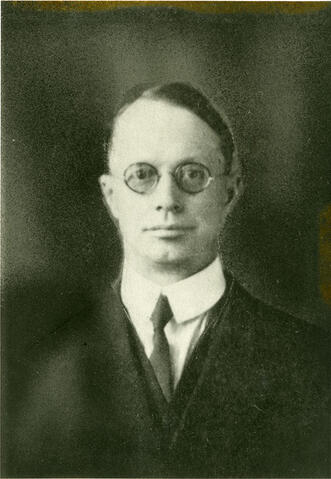
Zone du titre et de la mention de responsabilité
Titre propre
Dr. Samuel E. Greenway - Portrait
Dénomination générale des documents
- Document graphique
Titre parallèle
Compléments du titre
Mentions de responsabilité du titre
Notes du titre
Niveau de description
Pièce
Cote
Zone de l'édition
Mention d'édition
Mentions de responsabilité relatives à l'édition
Zone des précisions relatives à la catégorie de documents
Mention d'échelle (cartographique)
Mention de projection (cartographique)
Mention des coordonnées (cartographiques)
Mention d'échelle (architecturale)
Juridiction responsable et dénomination (philatélique)
Zone des dates de production
Date(s)
-
[before 1919] (Production)
Zone de description matérielle
Description matérielle
1 photograph : b&w ; 12.5 x 18 cm
Zone de la collection
Titre propre de la collection
Titres parallèles de la collection
Compléments du titre de la collection
Mention de responsabilité relative à la collection
Numérotation à l'intérieur de la collection
Note sur la collection
Zone de la description archivistique
Nom du producteur
Historique de la conservation
Portée et contenu
Head and shoulders portrait of Dr. Samuel Earl Greenway, Director of Extension.
Bio/Historical Note: Dr. Samuel Earl Greenway was born 16 February 1875 in Little Prairie, Wisconsin. He settled in Manitoba in 1880, and was in turn a farmer, teacher, telegraph operator, and reporter, editor and contributor to magazines. Dr. Greenway was involved in a pivotal event in the history of the University of Saskatchewan, known as “the University crisis of 1919.” The matter became public on June 28 when the Saskatoon Star announced that four members of faculty had been fired without explanation. They were: Samuel E. Greenway, director of Extension; Robert D. McLaurin; head of Chemistry; Ira A. MacKay, professor of Law; and John L. Hogg, head of Physics. All were senior members of faculty with many years of experience. The affair had started in March of that year when Greenway had accused Walter C. Murray, University President, of falsifying a report about University finances. This complaint had been made to the government and not to the Board of Governors. In early April Council voted 27 to zero “affirming its confidence and loyalty to the President” while four members abstained. Three of those who abstained plus Greenway were dismissed as the Board put it, “in the best interest of the University.” The public and the press clamoured for an explanation. When one was not forthcoming, calls for a public inquiry were loud and persistent. In accordance with the University Act, the Lieutenant Governor assumed the role of Visitor and through the office of the King’s Bench held a series of hearings. The Visitor’s report was delivered in April 1920 and vindicated the Board’s decision saying it was “regular, proper and in the best interest of the university.” The professors were not protected by tenure but were employed “at the pleasure of the board.” Their act of disloyalty was enough to cost them their jobs.
Zone des notes
État de conservation
Source immédiate d'acquisition
Classement
Langue des documents
Écriture des documents
Localisation des originaux
Disponibilité d'autres formats
Restrictions d'accès
Délais d'utilisation, de reproduction et de publication
Photographer: Unknown
Copyright holder: Public domain
Other terms: Responsibility regarding questions of copyright that may arise in the use of any images is assumed by the researcher.

